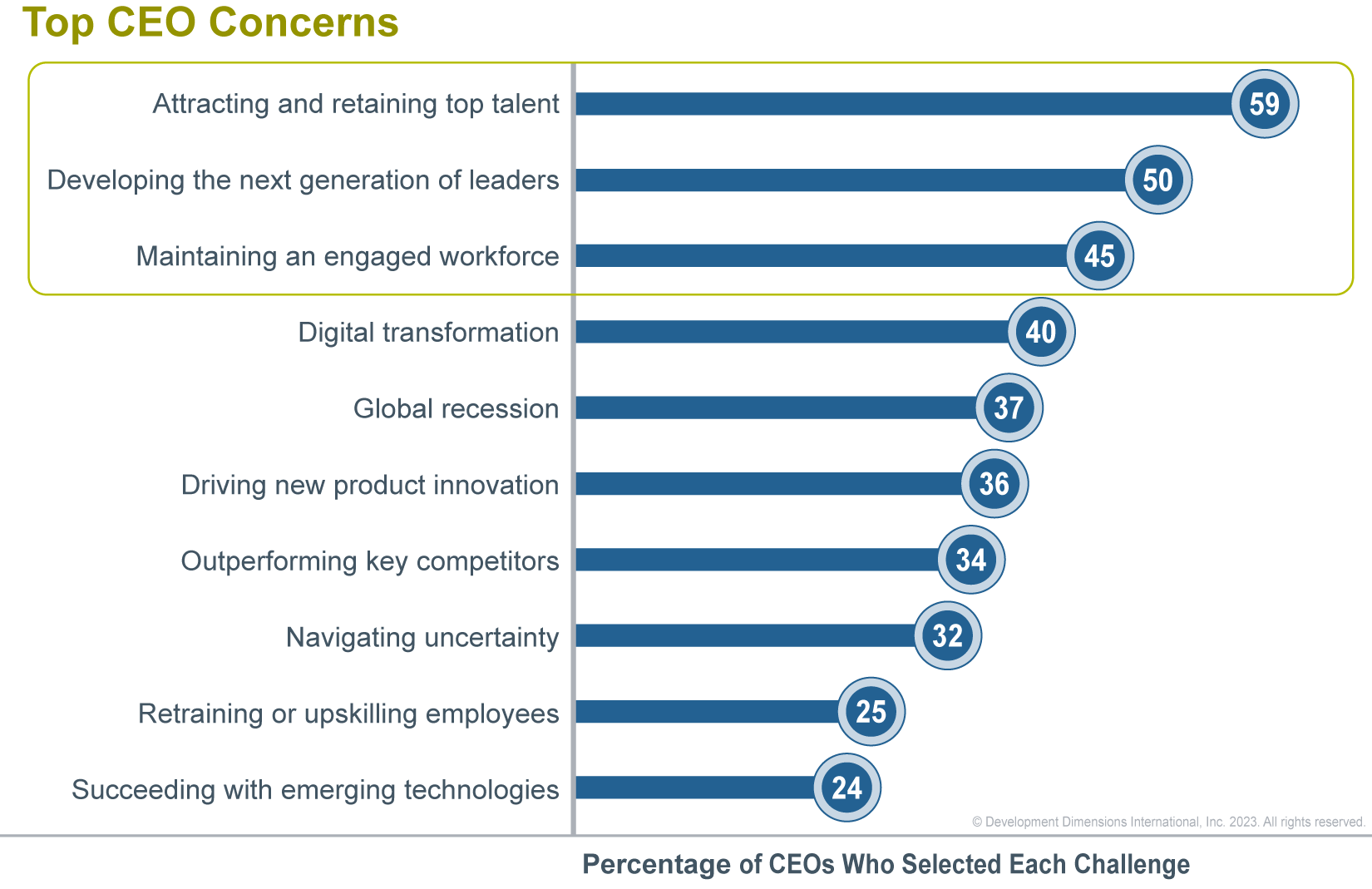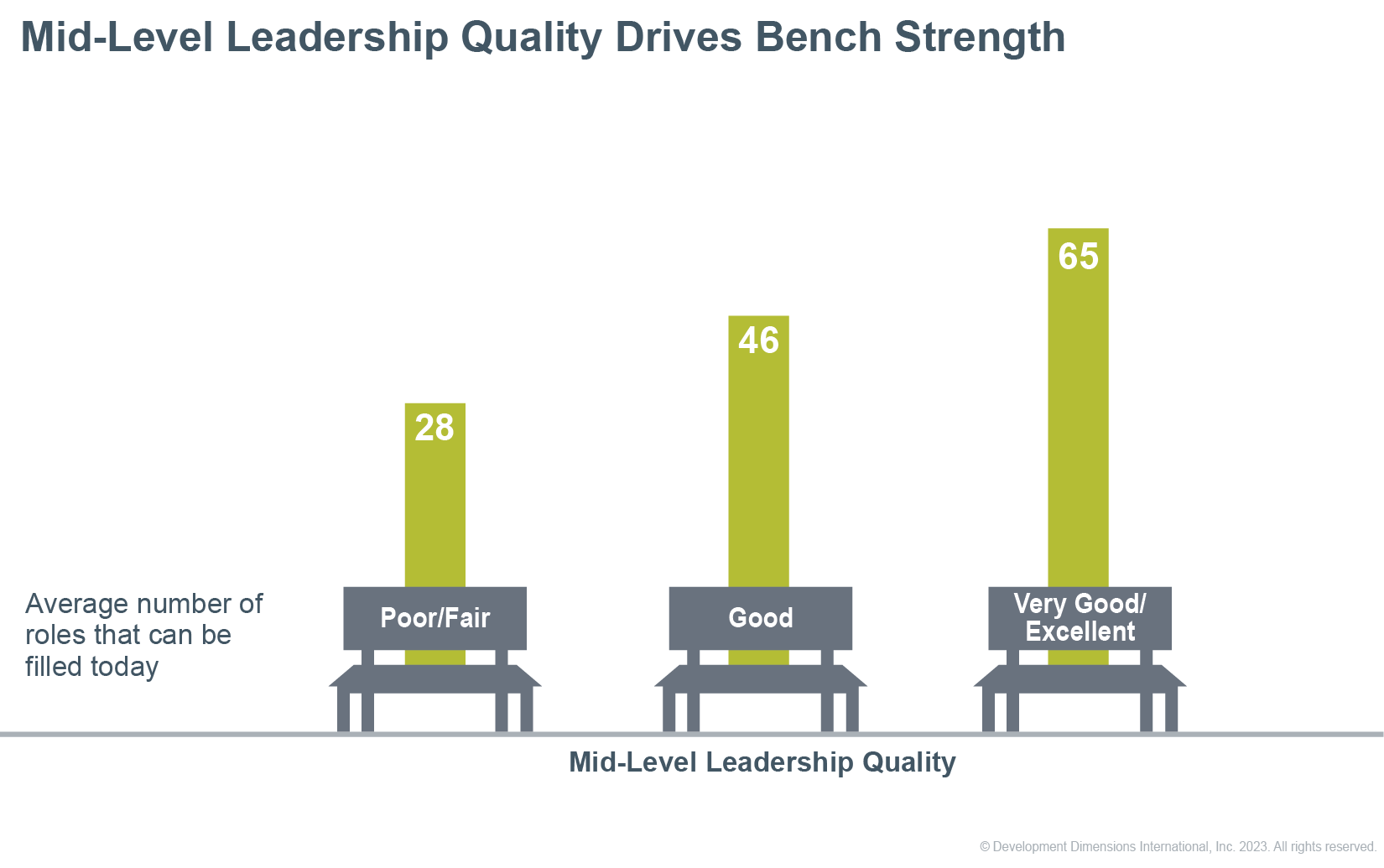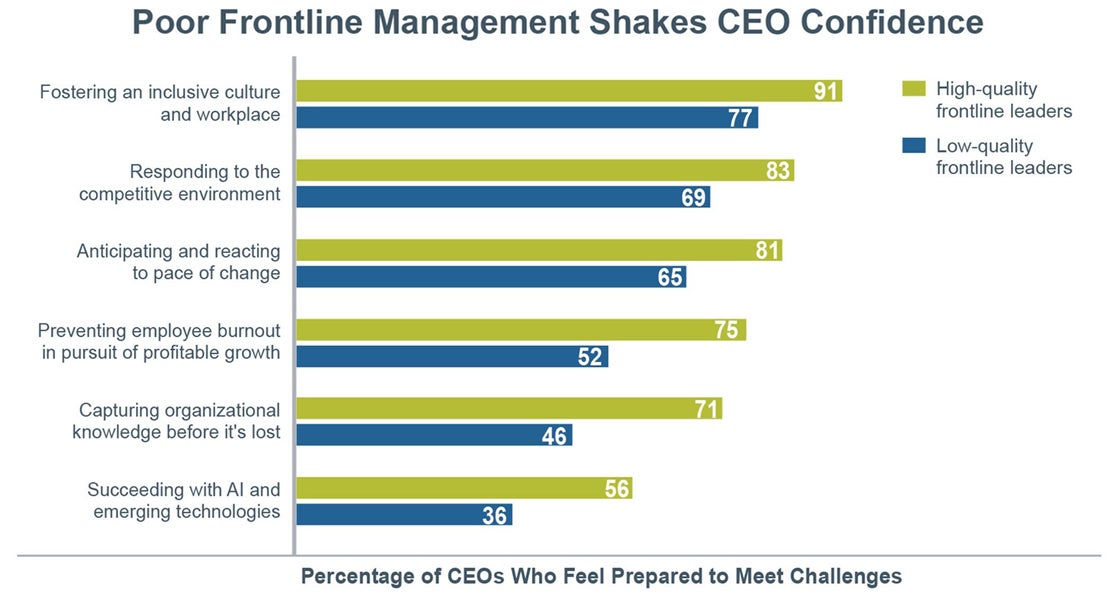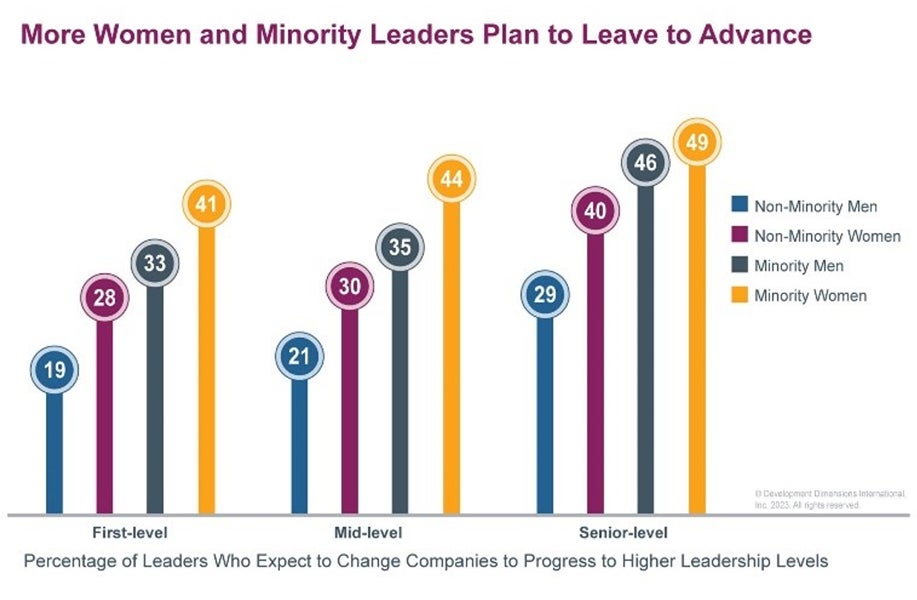The last thing that CEOs need in this fast-paced business and talent climate is to fall out of step with their employees and other leaders. Yet that is exactly what our latest research findings from Global Leadership Forecast 2023 reveal is happening at organizations around the globe.
It’s not that CEOs aren’t concerned about their people. On the contrary, all three of their top business concerns revolve around talent:
- Attracting and retaining top talent.
- Developing the next generation of leaders.
- Maintaining an engaged workforce.
Even though CEOs recognize how critical it is to have the right people to execute their business strategies, they may not be going about solving these top three concerns in the right way.

To gain deeper insights into how CEOs are approaching these growing talent concerns, we examined responses from more than 500 CEOs, coupled with findings from more than 13,000 leaders and 1,800 HR respondents published across our reports.
Across our data, we found several key trends around common CEO blind spots that may be affecting their talent and business strategy. Here are five of the common blind spots we found as well as insights into what the CHRO and HR team can do to help their CEO strategically course correct.
1. CEO talent visibility ends at their senior leadership team.
Despite worries about their bench and future talent, CEOs are often not seeing much beyond their senior leadership team. This is leading to one of their biggest blind spots: not being able to really perceive how their mid- and lower-level leaders are doing and performing.
CEOs may not be able to see the connection, but there’s an incredibly strong association between the quality of frontline leaders and CEOs’ own confidence in their ability to address key challenges. New data from our forecast showed that CEOs tend to be highly optimistic about how things are going in their organizations and their ability to meet future business challenges. However, they are much less confident when they don’t feel they have quality leaders at the front line.
It's clear that they are also undervaluing middle managers. Although CEOs were less likely to rate mid-level leaders as high quality, they play a powerful role in creating the talent backbone of the organization. Companies with high-quality mid-level leaders are able to fill 68% of critical leadership roles, compared to only 46% of roles in companies with average-quality mid-level leaders and 28% of roles in organizations with low-quality mid-level leaders.
Companies with high-quality mid-level leadership are also 3X more likely to be awarded a “best place to work” award compared to companies with poor- or fair-quality mid-level leadership. This makes this level of leaders pivotal to attracting and retaining talent that CEOs know is so crucial to future success.

What should the CHRO do? Help the CEO get data on their people. It will give them a much more accurate take on what’s going on in their organizations.
Although CEOs often struggle to see beyond their senior level, we saw gaps in perception shrink significantly among CEOs who said they rely on objective talent data, such as assessments and tests, to make decisions. When CEOs were armed with objective talent data, they were more likely to be able to understand how leaders are actually performing. They were also 2.2X more likely to have high-quality senior leaders to help deliver on their talent strategy.
2. CEOs have no idea how to approach AI and other emerging technologies—and don’t know how to get the right people in place to fix it.
One of the biggest technology concerns and opportunities for the foreseeable future revolves around advances in AI. However, this is the one area where the majority of CEOs said they are not confident and are struggling to leverage their capabilities. At the same time—and perhaps because they are so underconfident in this area—they rank it near the bottom of their concerns.
Companies often rely on skilled and knowledgeable technology workers on the front lines to guide their AI strategies. As a result, this is an area of CEO confidence that is highly variable depending on how they view the quality of their frontline leaders. If CEOs don't have capable leaders in the mix, they know their plans for AI won't pan out.

What should the CHRO do? Focus on developing technology leaders who can be strong networkers and highly influential. They can’t just be experts in their field but have to be able to convince others—including the CEO—of how to truly embrace emerging technologies.
In those cases, CEOs should lean on their HR partners to help improve their managers' leadership skills, turning things around.
3. CEOs are completely overestimating how well they are doing on diversity and inclusion.
Where AI was the area CEOs were least confident, we saw that their confidence was at a maximum for how well they foster an inclusive culture. This high level of confidence puts CEOs out of touch with employees, especially their managers at the front lines who have a clearer view of how employees are feeling about their culture. Only 24% of frontline managers said that inclusion is a strong part of their culture.

Not only does CEOs’ over-confidence on the state of inclusion seem out of step with what employees say, but also with the rates of underrepresented talent ready to leave their organizations. Women and minorities are significantly more likely to leave their companies than other employees. This is true especially at the senior level where women are 1.5X more likely to say they need to leave to advance their careers. This should be a high level of concern for CEOs, given their anxiety over the strength of their leadership bench.
What should the CHRO do? While many CHROs have been sounding the bell on DEI for a long time, they need to constantly reinforce the business case with their CEOs. Building on a swath of evidence for the impact of diversity on business, we found that organizations with above-average diversity are 2.4X more likely to outperform their competitors financially.
CHROs can also reinforce that DEI is critical to attracting and retaining top talent at every level. By helping them use this data and gather feedback in their own organization about how people really feel about inclusion, they can help prevent CEOs from having misperceptions based on gut instinct.
4. CEOs aren’t focused enough on building purpose and trust.

Purpose is a top driver of employee engagement and retention, and yet more than one-third of CEOs say that even they struggle to find purpose in their jobs. Those numbers dwindle lower down in the organization, with fewer employees feeling a sense of purpose at each level below.
At the same time, we’re also seeing employees say they don’t trust their senior leaders. Only one-third said that they trust their senior leaders to do what is right. And their confidence in leaders has dropped significantly, with 20% fewer employees rating the quality of their company’s leadership as high, compared to our last study.
This lack of trust is also a key reason that so many women and minority leaders say they intend to leave their companies. Worse, many CEOs are going in the wrong direction, and further risking the trust of their people in current moves to impact their culture. For example, many CEOs think that bringing people back to the office will help to build purpose and trust, but it has the opposite effect as we have seen with recent strikes and employee walkouts.
What should the CHRO do? Help the CEO reconnect with what’s driving them personally as well as how they are going to convey that sense of purpose to the organization. Communicating this along with purposefully building trust with employees will be in service of their goals to retain and build talent for the future.
5. CEOs fail to value the dynamics of their executive team.
One of the most common—and enduring—CEO blind spots is the performance of their executive teams. And it’s getting worse in the post-COVID era.

In fact, 68% of CEOs now say their executive team is not very effective at driving strategy forward, compared to 63% in 2020. Leaders lower in the organization are even less optimistic. Among senior leaders, 75% say their executive team is not very effective, which marks a significant increase since 2020.
There are several factors that may be causing the drop in confidence of executive teams. One likely factor is the challenge of leading post-pandemic as employees tire of constant exhaustion and uncertainty. Another key factor is the Great Resignation. As many companies have struggled to retain their top talent, they may have had to promote people to key roles before they were ready, leave them open, or fill them with people who were not an ideal fit.
Despite the timely challenges that are exacerbating the issue, the deeper cause of executive team ineffectiveness lies with the CEO. Often, CEOs surround themselves with highly talented senior executives who excel in their individual functions. However, many CEOs fail to account for how the executives work together as a team.
The result is often a team of individual high performers who may fail collectively as they struggle to collaborate across the organization.
What should the CHRO do? Help the CEO drive more effective team dynamics around the C-suite. This requires both objective data as well as focused work to help them address the behaviors and personal tendencies of the team that will help them become more effective as a cohesive unit.
CEOs Are Leaning on CHROs
With continued talent churn and a lot of uncertainty in the market, CEOs are rightfully worried about their ability to meet business challenges without stronger talent capabilities. That creates a golden moment for CHROs to shine as talent strategists who enable the CEO and the business to accomplish ambitious goals. The challenge is that their success depends on having a strong relationship with a CEO who wants to uncover their blind spots about talent, rather than assume they already have the answers.
CHROs who strategically use data to influence and help their CEOs overcome those blind spots will enable their companies to emerge as winners in the economy ahead.
To see more insights about CEO perspectives on leadership talent, explore our CEO Leadership Report 2023.
Stephanie Neal is director of the Center for Analytics and Behavioral Research (CABER). She leads market and trend research focused on leadership and business innovation and is the general manager and lead author of DDI's Global Leadership Forecast.
Topics covered in this blog

